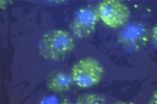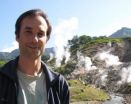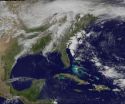(Press-News.org) Brandeis researchers have made a significant advance in the effort to understand amyotrophic lateral sclerosis (ALS) by successfully reversing the toxicity of the mutated protein in the familial type of the disease.
Currently there is no cure or prevention for the disease, which affects nerve cells in the brain and the spinal cord. Most frequently referred to as Lou Gehrig's disease, after its most famous victim, ALS typically causes death due to respiratory paralysis within three to five years of onset. The only approved drug, Riluzole, can extend the lifespan of some patients by three months.
In a paper published Tuesday, April 26 in PLoS Biology, the Pestko/Ringe laboratory reports success in blocking the lethal effects of the gene by placing several human genes into a yeast cell that shows many similar features to the disease-causing proteins.
Genes have been identified for many of the 10 percent of ALS cases that run in families. People with one of those mutant genes are likely to develop the disease. While a few of those genes might also contain mutations that increase risk for the more common forms of ALS, it's one of those genes, FUS/TLS, which got the attention of the Pesko/Ringe team.
"We started to work on this project when we learned that mutations of FUS/TLS gene were linked to familial ALS by our collaborators, Dr. Robert Brown's group, at the University of Massachusetts medical school," says Shulin Ju, a post-doctoral researcher and first author of the paper. The collaboration also includes members of Whitehead Institute for Biomedical Research, MIT, Harvard University, University of Rochester and the University of Pennsylvania.
Here is some of the biology and chemistry behind the research:
Post-mortem examinations of certain ALS victims show that the dying neurons contain clumps of the FUS/TLS protein. What's interesting, says Gregory A. Petsko, professor of chemistry and biochemistry, is where these inclusions are.
"Normally this protein lives in the nucleus of the cell, which is where the chromosomes are," says Petsko. "In this disease, it seems to move from the nucleus out into the cytoplasm of the cell, the main part, and that's where it forms the inclusions that are associated with the disease."
Petsko and Ringe's team wanted to study this process in an organism on which they could perform sophisticated genetic screenings and detailed biochemical experiments, which can not be done in human cells. So they chose yeast.
"It may seem kind of crazy to think of doing yeast experiments on a human neurologic disease, since yeast has no brain or spinal cord or any neurons at all," says Petsko, "But a yeast cell isn't that different from a typical human cell."
The team inserted the FUS/TLS gene into a yeast cell with the hope that it would create the same observable characteristics as the mutant protein does in a human cell. When they did, Petsko says, two remarkable things happened.
"First thing is that the human protein wasn't in the nucleus, it moved to the cytoplasm of the cell just like it did in the human disease— and it formed inclusions," says Petsko. "The second thing is that it killed the yeast cell, so we got in yeast a pretty faithful replication of some of the features of the human disease caused by mutation of this gene."
The next step was to find out what part of the protein was necessary in order to keep it in the nucleus and what part was necessary to send it to the cytoplasm.
Petsko then asked, "If we started deleting sections of the protein could we force the protein to always be in the cytoplasm or always be in the nucleus?"
When they performed the experiment with yeast they found that the area of the gene where the disease-causing mutations occur was the area responsible for keeping it in the nucleus; when that area is mutated, the gene leaves the nucleus for the cytoplasm.
"We want to keep it in the nucleus but you can't do that with the mutants easily because the part responsible for keeping it in the nucleus has been destroyed by the mutation, which is why you have the disease," says Petsko.
They then asked whether they could prevent the yeast cells from being killed by this protein by placing some other protein inside.
In other words, Petsko says, could they find a protein that would rescue the cell from the toxicity of FUS/TLS?
By a series of genetic experiments described in the paper, they were able to identify several human genes which, when inserted along with FUS/TLS gene, rendered FUS/TLS protein no longer toxic to yeast. The cells survived.
"And then we got the surprise of our life," says Petsko. "When we looked at those cells, FUS/TLS protein was still in the cytoplasm, and still forming inclusions. In other words, we were able to eliminate the toxicity of the protein without sending it back to the nucleus."
What this told them was that aggregating and being in the cytoplasm didn't necessarily have to be toxic as long as the rescue protein that they found was introduced.
That, says Petsko, got them really excited, because "if you can do that with the expression with another human gene you could probably do that with a drug."
INFORMATION:
Researchers at Brandeis University make strides in understanding amyotrophic lateral sclerosis
Laboratory reports success in blocking the lethal effects of ALS
2011-04-27
ELSE PRESS RELEASES FROM THIS DATE:
Cold case: Siberian hot springs reveal ancient ecology
2011-04-27
Exotic bacteria that do not rely on oxygen may have played an important role in determining the composition of Earth's early atmosphere, according to a theory that UChicago researcher Albert Colman is testing in the scalding hot springs of a volcanic crater in Siberia.
He has found that bacteria at the site produce as well as consume carbon monoxide, a surprising twist that scientists must take into account as they attempt to reconstruct the evolution of Earth's early atmosphere.
Colman, an assistant professor in geophysical sciences, joined an American-Russian team ...
iQuote Motor Trade Insurance - European New Car Sales Falling in Q1
2011-04-27
The Europe wide figures for new car sales across Europe fell by nearly 2 percent in the first quarter of the year. Whilst some countries experienced an increase a number of factors, including economic troubles in Portugal and Greece contributed to the overall reduction. Within the top five markets: Spain, Italy and Great Britain all experienced negative retail figures for new car sales.
Whilst this is gloomy news for much of the Motor Trade (particularly within the UK), there have been some brands that have bucked the trend. Alfa Romeo sales have increased 60 percent ...
GOES-13 satellite eyeing system with a high risk of severe storms
2011-04-27
A low pressure area currently over northern Illinois and southern Wisconsin has created conditions that call for a forecast of severe weather in the eastern third of the U.S. today and one area is even labeled "high risk." The GOES-13 Satellite captured a visible image of the system today as daytime heating was boiling up strong and severe thunderstorms.
What's unusual about the system is that there are a handful of days where a "high risk" for severe weather is noted by NOAA's National Severe Storms Laboratory (NSSL). Today, April 26, 2011 is one of them. The high risk ...
Suffern Parking Authority Selects RingGo to Modernize Village and Train Station Parking: Pay By Cell Phone Service Increases Customer Convenience And Improves Parking Operator Efficiency
2011-04-27
The Parking Authority of Suffern, New York is launching RingGo Pay by Cell Phone service beginning April 26, 2011. The new service is available for nine village lots including the daily parking spaces at the Suffern Train Station. As an added convenience, Suffern residents may now purchase monthly parking permits through RingGo.
This state-of-the-art system makes paying for parking far more convenient for Suffern's residents and visitors. Instead of having to make sure they have the right amount of cash or coins or walking and standing in the snow at the honor boxes, ...
New study: Health reform to make health insurance affordable for nearly all families
2011-04-27
New York, NY, April 27, 2011—Ninety percent of American families living above the federal poverty level will be able to afford health insurance under the Affordable Care Act, according to a new Commonwealth Fund report by Jonathan Gruber and Ian Perry of the Massachusetts Institute of Technology (MIT). The report finds that new subsidies available through health insurance exchanges established under the law will make premiums affordable for most families. But the authors also warn that high out-of-pocket costs will likely mean some families will still be unable to afford ...
Spread-Betting.com Unveils A New Educational Website For Traders And Investors in the UK
2011-04-27
A new true trader's journal, www.spread-betting.com has been revamped online and introduces a new clean design with a user-friendly interface aimed at educating investors.
Spread-Betting.com is the UK's new leading trade journal and tutor for investors who seek answers regarding financial spread betting. With information on oil, gas, silver, wheat or simply a question of a certain stock doubling in value, www.spread-betting.com is answering important questions concerning how one might bet the Dollar against the Euro or Pound against the Euro; questions about the Nasdaq ...
AgilQuest Corporation: Government Agencies to Learn Keys to Successful Telework Programs and Funding
2011-04-27
AgilQuest Corporation, a business focused on workplace flexibility and real estate optimization, is a sponsor at the upcoming Telework Exchange Town Hall meeting. AgilQuest will demonstrate services and technology to create telework programs and explain how agencies can shift budgets to fund the telework mandates.
Telework Exchange's Town Hall Meeting will be held on Thursday, April 28 at the Ronald Reagan Building in Washington, D.C. Government agencies will attend classes and speak to exhibitors as they work to comply with the recent Telework Enhancement Act of 2010.
"The ...
Homeowners Insurance Quotes Simple to Compare at InsuranceAgents.com With Their New Side-by-Side Insurance Quote System
2011-04-27
With InsuranceAgents.com, consumers can easily compare homeowners insurance quotes from multiple top-rated companies. This is why the service can proclaim with confidence, "We do all the work for you."
Insurance consumers report that shopping for homeowners insurance quotes, especially the first time, can be a difficult process as they struggle to find the right coverage at the right price that is represented by the right insurance agent.
Unfortunately, they may not discover they made the wrong decision until a future date when they have already experienced ...
Rapid Action Tools Continue to Drive Faster and Bigger Lean Six Sigma Results
2011-04-26
More and more organizations are adding Rapid Actions Tools to their Lean Six Sigma Deployments to drive faster and bigger results. Rapid Action Tools complement traditional Lean and Six Sigma methods with a just-in-time, simple to deploy process and toolset for engaging frontline employees in 60-day or shorter rapid improvement projects.
According to Lean Six Sigma Deployment Leaders adopting the toolset, major benefits delivered are reduced project cycle-times, increased Belt productivity and faster cultural change by expanding engagement of leaders and employees at ...
Smith & Wesson Hosts First Scholastic Steel Challenge Collegiate Spring Championship
2011-04-26
The Steel Challenge Shooting Association (SCSA) announced that the organization's first collegiate event in the Scholastic Steel Challenge program will be hosted by firearms maker Smith & Wesson with targets provided by Action Target. The match will take place May 7-8 at the Hartford Gun Club in Hartford, Conn.
The Scholastic Steel Challenge Collegiate Spring Championship will feature a two-day format with instruction and demonstrations on setting up and running the various Steel Challenge stages followed by team practice sessions on day one. Team competition will ...
LAST 30 PRESS RELEASES:
Rare image of Tatooine-like planet is closest to its twin stars yet
Music: Popular song lyrics have become more negative since 1973
Marine ecology: Killer whales tail dolphins to hunt salmon
ADHD prescriptions on the rise, study finds
How to build a genome
Sharp rise in ADHD stimulant prescriptions in Ontario, research finds
Trends and prevalence of the metabolic syndrome among US adults
Population-level trends in ADHD medication prescribing
Missing piece of myelin disturbs the brain’s rhythm
Insilico Medicine and Taigen achieves license agreement to develop and commercialize AI-driven PHD inhibitor for anemia of Chronic Kidney Disease (CKD)
Exploring dominant endophytic Pleosporales in grasses: New taxonomic insights in the suborder Massarineae
Comparative transcriptomic analysis of human maxillary and mandibular tooth germs reveals discrepancies in gene expression patterns
Scientists detect atmosphere on molten rocky exoplanet - study
Chip-scale magnetometer uses light for high-precision magnetic sensing
Illinois Tech biomedical engineering professor Philip R. Troyk elected as Fellow of the National Academy of Inventors
The National Academy of Inventors welcomes 2025 Class of Fellows
Multi-scale modelling framework predicts mechanical responses of Fe–Cr–Al alloys across composition and processing conditions
Preoperative radiation may improve antitumor immune response in most common form of breast cancer
Breast MRI may be safely omitted from diagnostic workup in certain patients with early-stage, HR-negative breast cancer
Sentinel lymph node biopsy may be safely omitted in some patients with early-stage breast cancer
Rats may seek cannabis to cope with stress
New FAU research strengthens evidence linking alcohol use to cancer
Gut health à la CAR T
Dr. Pengfei Liu receives 2026 O'Donnell Award in Medicine for pioneering advances in genetic diagnostics and rare disease treatment
Dr. Yunsun Nam receives 2026 O'Donnell Award in Biological Sciences for pioneering RNA research transforming gene regulation and cancer therapy
Dr. Bilal Akin wins 2026 O'Donnell Award in Engineering for transformative work in EV energy systems and industrial automation
Dr. Fan Zhang receives 2026 O'Donnell Award in Physical Sciences for groundbreaking discoveries in quantum matter and topological physics
Dr. Yue Hu receives 2026 O'Donnell Award for revolutionizing energy operations with real-time AI and reinforcement learning
Greater risk that the political right falls for conspiracy theories
JMC Publication: Insilico’s AI platforms enable discovery of potent, selective, oral DGKα inhibitor to overcome checkpoint resistance
[Press-News.org] Researchers at Brandeis University make strides in understanding amyotrophic lateral sclerosisLaboratory reports success in blocking the lethal effects of ALS


